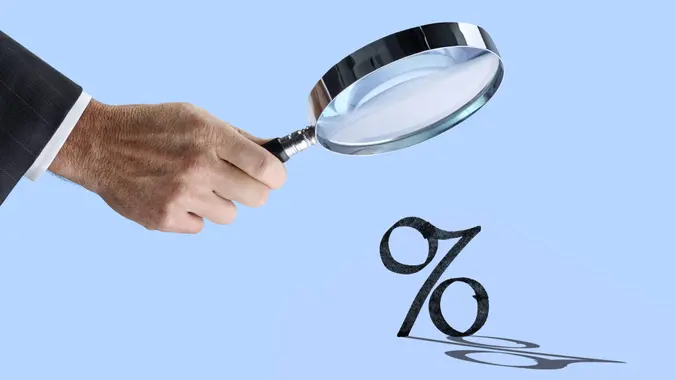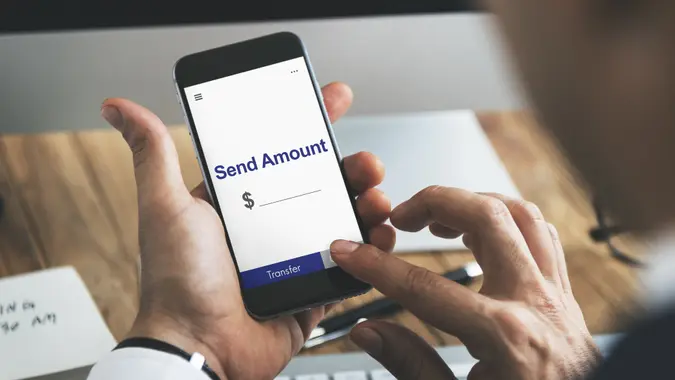I’m a Bank Expert: My Favorite Type of Bank Account for Each Financial Goal

Commitment to Our Readers
GOBankingRates' editorial team is committed to bringing you unbiased reviews and information. We use data-driven methodologies to evaluate financial products and services - our reviews and ratings are not influenced by advertisers. You can read more about our editorial guidelines and our products and services review methodology.

20 Years
Helping You Live Richer

Reviewed
by Experts

Trusted by
Millions of Readers
A recent banking survey from MarketWatch found that respondents had an average checking account balance of $11,195.38 and that the most important feature of this account was having low or no monthly fees. The survey also discovered that 52.5% of respondents had a savings account with a traditional bank, while 29.7% had it with an online bank and 16.6% had their savings at a credit union.
While most banking customers understand that a checking account is ideal for your daily or fixed expenses, many may not be aware of other types of bank accounts. Depending on your financial goals and priorities, there are various bank accounts that will make sense for you.
If you’re new to banking accounts or looking to get more out of your accounts, take a look at these favorite types of accounts for each financial goal.
Also see seven reasons you shouldn’t keep more than $3,000 in a checking account.
Emergency Fund: Savings Account
“A savings account with a market-leading rate is a great place to keep your emergency savings,” said Ben McLaughlin, a banking expert and president of Raisin, an online savings platform. “Your money will be working hard for you while remaining easily accessible, should you need it.”
Banking experts agree that you should keep your emergency fund in a savings account that earns you some interest while remaining liquid so that you have access to your money as it grows.
If you want to maximize your earnings, you should look into high-yield savings accounts, as they’ll pay you even more, with rates around 5%. Since the recommendation is to set aside anywhere from three to six months’ worth of living expenses in your emergency fund, you’ll want this decent chunk of change to earn you some interest instead of sitting around.
Building Extra Savings: Certificate of Deposit
Once you’ve ensured that you have the funds in your checking account to handle your bills and a significant amount in your emergency fund, you can look into a CD with your banking provider for extra savings.
“For those that have a more difficult time not touching their funds and want to save money for their future, they can open a certificate of deposit (CD), which puts the members’ funds into a share that they cannot touch until their maturity date comes,” said Zachery Calkins, a relationship advisor and former head bank teller at Addition Financial Credit Union. “These typically pay out higher dividend rates as well as a bonus perk for leaving the funds there.”
“CDs are great for building your savings with extra funds that you don’t need access to for the duration of the term,” McLaughlin said. “You can use CDs to help build your retirement savings or nest egg or to supplement savings for a big life event or purchase.”
If you have any major purchases coming up in the next few years, you’ll want to ensure that your funds are growing at a respectable rate to reach your goals faster. And a CD is a great option.
“If you’re saving for a vacation or a new car and already have a healthy emergency fund you can access easily, locking some extra money on a market-leading CD can earn you guaranteed extra interest to boost your savings. The extra interest might fund a special excursion or extra bells and whistles on your new car,” McLaughlin said.
While banking experts agree that a CD is the ideal bank account for building extra savings, there’s one caveat. “They have a penalty for withdrawing it early. This option typically appeals to individuals who don’t need the funds immediately,” Calkins said.
Large Savings Goals With Liquid Funds: Money Market Account
“Money market accounts are also a great way to tuck money and earn dividends on those funds just by leaving the money in the account,” Calkins said. “You can even use these savings accounts as another set of overdraft protection to make sure you’re always covered in the event that something unexpected happens.”
You can look into money market accounts if you want access to your money as your funds grow. While a CD typically offers higher rates, the funds are more liquid with a money market account. As always, you should consult a banking professional to determine what account type is right for you and your financial situation.
Planning For Retirement: 401(k)
When it comes to planning for retirement and making sure you’re ready when the time is right, Calkins recommended having a 401(k). “The reason for this is these funds automatically come out of your paycheck every pay period to put aside some money for your retirement plan. Not to mention, a lot of companies will match up to a certain percentage of what you put in to help you further build your retirement funds,” he said.
It’s not a secret that many banking experts will recommend that you open up a 401(k) account and take advantage of any plans you have access to. This account will help you grow your retirement nest egg so that you’re prepared to exit the workforce someday.
 Written by
Written by  Edited by
Edited by 
























